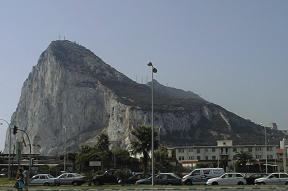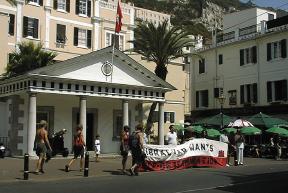
Gibraltar
July 22nd - July 25th, 1999

We've been in Spain and Portugal a month now and feel like it's time to bid them adios and head south into Africa. There are many choices for jumping off points, but we settle on Gibraltar. Part of it was to see this natural wonder of upthrust limestone, and part of it was to get a taste of the days when the British Empire was a grand and world-embracing thing. A big part of it was to be in a nice, easy English-speaking environment with familiar style shops, pubs and food. Also, one never knows -- while relations between the English and Spanish are currently cordial, the Spanish feel Gibraltar is rightfully theirs and do want it back. There may be a day where the sun will set on this little corner of the empire, and we couldn't pass up a chance to sample it as it is today.
As a tourist, there's a lot to see and do on the rock and the authorities have made every effort to make it organized and accessible. Most chose to sample Gibraltar's delights as a long day trip (usually topped off with shopping). One starts with a cable car ride to the top of the rock, pausing to take in the view, and then sauntering your way down the hill, stopping at all the little tourist sights. The first of our favorites was St. Michael's cave. A large natural cavern, the British enlarged it for a military hospital during World War II and after the war converted it to a large theater. A symphony orchestra and several hundred people can fit it in now! The first neanderthal skull ever found came from St. Michael's, although it wasn't recognized as an ancestor of man until the discovery and identification of a neanderthal skull in Germany a few years later.
|
|
Brought from Africa by English traders in the 18th century, Gibraltar now has several packs of semi-tame monkeys. The little beggars are laying around all over the rock. Below left is a shot of a big male waiting for someone to come on over and feed him (we don't feed monkeys) and below right is a reclusive female with her infant.
|
|
At the northern end of the rock are the Great Siege Tunnels, built into the limestone over a few months so the British could flank a prolonged Spanish attack. Carved with drills and dynamite, the tunnels come complete with several groups of mannequins reenacting how the British gave those nasty attackers the what-for.
|
|
Even though Gibraltar is British, the majority of the island's daily population are Spanish -- either day workers or guest workers living on the rock. As such, there is friction about being administered by a land as far away as England, and one day we were there we saw a small protest by the rock's inhabitants demanding self-determination. Makes one wonder how things can stay the way they are here.

Ah, British Pub culture! We were fortunate enough to rub elbows with a few of the locals. Here's a shot of Kathy with Bob and his lovely daughter Lorraine -- we got to spend the better part of an evening bending elbows and chatting about life on the rock.

We do have to admit, however, that Gibaltar may not be the best jumping off point for Africa. The English bookstores were small and not especially well stocked on African literature, the fish for the fish and chips is not fresh but rather flown in from England, and most of the stores in general were a little expensive. Seems Gibaltar is more geared for the day tourist who comes in and stocks up on duty free liquor and cigarettes. It was nice to stock up on those pints, though.